
BEHIND THE SCENES: HOW WE FARMERS' MARKET
10/16/20 — Ada Broussard
Each week, we attend 12 different farmers' markets https://jbgorganic.com/markets . The closest market to our farm is the Mueller Market on Sundays, but we also make the trek to Katy each Saturday for our beloved Memorial Villages Farmers’ Market. Depending on the market, our staff usually sets their alarm clocks for 4 am, giving them enough time to get to the barn for a 5 or 5:30 am start time. Waking up early and schlepping a truck to a market is a regular ritual for many small farmers across our country who farm in rural areas and then must travel to their customers, who are clustered in urban ones.
![]() Nao, Rich, Marcela, & Jerry: Our Downtown Crew!
Nao, Rich, Marcela, & Jerry: Our Downtown Crew!
We work hard to fill our booths with mesmerizing mountains of beets and colorful carousels of carrots. These displays are more than pretty pictures, however, and we’re also creating a layout that is ergonomic for our staff and makes for a safe and pleasurable experience for our customers. We’ve been attending markets for over 15 years, and we’ve got a system down! We hope that when you visit us on Saturday or Sunday morning we make the veggie business look easy. But of course, there is an enormous amount of sweat, figuring, and planning that goes into creating a mobile and temporary produce stand. This week we are pulling back the curtain and showing you what goes into our weekend market display, a display that wouldn’t be possible without our fun-loving and talented market staff…. and the reliable functioning of their 4am alarm bells.
THURSDAY AND FRIDAY: Our Farmers Market Manager, Jerry, works on a Thursday through Monday schedule. Thursdays and Fridays Jerry spends the majority of his day hidden away in our coolers, a series of four separate rooms (and two sizeable cubbies), most of which are linked together by large and cumbersome doors and rubber curtains that make you feel like you’re entering a car wash everytime you push your way through. On Thursdays and Fridays, Jerry is charged with the enormous task of “building the market pallets”. Each market has an unofficial official parking spot in the aptly named “market cooler” and on Thursday mornings, Jerry begins by placing empty pallets in the designed areas. Over the course of two days, Jerry will build the pallets with freshly washed, sorted, and sometimes bagged produce, making sure to send a little bit of each item to every market. The quantities he’s packing aren’t random. The number of cucumbers we send to the Sunset Valley market, for example, is a finely tuned figure based off annual records, as well as the “market notes” and sales records from the previous weekend.
Even though Jerry works sometimes a 13 hour day on Saturdays, when asked he said Friday was his most challenging day at work. Head to any market JBG attends and right now you'll see bulk beets. If you love beets, you can thank Jerrry! Each market gets around 2-3 bins of beets (each weighing about 35 lbs.) and Jerry is responsible for physically packing and stacking those 1,000 lbs of beets. And those are just the figures for beets… we sometimes send upwards of 30 different items to market. We’ll save Jerry the headache of seeing the full figures, but he no doubt moves, carries, and shuffles thousands of pounds of vegetables every week, and the weekend’s smooth success depends on his dedication.
FOUR AM TO 7AM SATURDAY MORNING: Market mornings start out at our Hergotz Packing Shed (Barn) location. On Saturdays we attend 8 markets, making it the busiest market day by farm. Market drivers with the early shift arrive at the Barn at 4:30am, and those with the late shift roll in at 5:30. Once drivers arrive, they begin a synchronized dance of carts, forklifts, and pallet jackets, all happening in the dark. It’s well rehearsed, and most mornings things go smoothly. There are two main groups working alongside each other on Saturday mornings: those JBGers driving vans to market and those operating the box trucks. The drivers departing in a van work pretty independently on Saturday mornings. If there was one tragedy of the market setup, it’s that the openings in the back of our vans are too small to load vegetables with a forklift. For this reason, van drivers are responsible for hand-loading their bins of produce and market supplies, all the while muttering a prayer that they return home with a significantly emptier truck.
The drivers that operate our big box trucks, and extra long reefer truck, are responsible for managing our busiest markets (bigger markets = more vegetables = bigger trucks). These bigger vehicles will roll-top doors are loaded with a forklift, and these drives all work together on Saturday mornings, some pulling out and staging vegetables with the pallet jacket, and another loading by the light of the forklift. Somehow, our amazing market managers navigate the loading dock’s dark corners, pushing and pulling literal tons of fresh without anything going wrong, even though technically, anything could fail. Think: dead forklift, flat tires, missing CSA boxes. If all goes as smoothly, the vans are gone and the trucks are loaded by 6:30 am. The next 30 minutes, there as a buffer, are ideally spent filling water bottles, perhaps some light stretching, and chatting about the new vegetables or new protocol that will be rolled out at market. By 7:05 am, the Hergotz loading dock, once a maze of forklifts and towering pallets of vegetables, is empty, the lingering smell of freshly brewed coffee floating above the concrete.
![]() Jerry in his office on Friday morning, pulling out a pallet of CSA boxes.
Jerry in his office on Friday morning, pulling out a pallet of CSA boxes.
![]() Thankfully, the area under our barn is well lit, and collisions of carts and jacks are rare.
Thankfully, the area under our barn is well lit, and collisions of carts and jacks are rare.
![]() A driver taking a van to market must hand-load market supplies like tables, tents, and of course: vegetables.
A driver taking a van to market must hand-load market supplies like tables, tents, and of course: vegetables.
![]() Fork lift dances.
Fork lift dances.
![]() Jerry making sure every market has their merch bin, credit card machine, and hand sanitizer.
Jerry making sure every market has their merch bin, credit card machine, and hand sanitizer.
![]() Amy loading all of the market supplies onto a box truck. Tents, tables, scales, and supplies are stored together on metal farmes that we call "wunder pallets". With a forklift, all of these supplies can be loaded at once onto a box truck.
Amy loading all of the market supplies onto a box truck. Tents, tables, scales, and supplies are stored together on metal farmes that we call "wunder pallets". With a forklift, all of these supplies can be loaded at once onto a box truck.
![]() Lights, camera, action. By 7:05, all of these trucks will be long gone.
Lights, camera, action. By 7:05, all of these trucks will be long gone.
AT MARKET: Our photographer Scott followed behind as Jerry left dusty Hergotz Lane and headed a couple of miles west, to SFC’s Downtown Market. Over the past 10 years, Scott has captured thousands of moments of farm life. But even for Scott, the process of market setup was a mystery. Like any good event, no one is supposed to see the setup, correct? At each and every market we attend, our market staff is usually the first to the scene. Slowly, other vendors arrive, and empty parking lots transform into bustling markets where you can get your mushrooms, vegetables, meats, and coffee all in stop.
Like the dance that happens at the Hergotz loading dock, the actual setup of tents, tables, and displays of vegetables is a choreographed routine where muscle memory and artistic intuition manifest into an organic produce shop that would rival many grocery stores. Take a look at Scott’s photos to see each setup step.
![]() We're usually the first scene at the farmers' market. First step: open the door.
We're usually the first scene at the farmers' market. First step: open the door.
![]() Open the tents. Marvel at early morning sky reflected in the surrounding skyscrapers.
Open the tents. Marvel at early morning sky reflected in the surrounding skyscrapers.
![]() Don't forget to attach the sign before you raise the tent. That's a rookie mistake.
Don't forget to attach the sign before you raise the tent. That's a rookie mistake.
![]() Safety first: attach the tent weights before doing much else. These are home-made weights - pvc pipes with a metal foot at the bottom, clip at the top, filled with concrete.
Safety first: attach the tent weights before doing much else. These are home-made weights - pvc pipes with a metal foot at the bottom, clip at the top, filled with concrete.
![]() Unloading: One person stands in the back of the truck and deliveries all the supplies to the rim, including a cooler of water so we can stay hydrated.
Unloading: One person stands in the back of the truck and deliveries all the supplies to the rim, including a cooler of water so we can stay hydrated.
![]() Jerry builds the soon-to-be veggie displays with stacked ifcos. Marcela sets up the CSA table.
Jerry builds the soon-to-be veggie displays with stacked ifcos. Marcela sets up the CSA table.
![]() Did you know that you can schedule to pickup a CSA box at a farmer's market? Pay ahead of time, grab and go.
Did you know that you can schedule to pickup a CSA box at a farmer's market? Pay ahead of time, grab and go.
![]() Coloring in the lines.
Coloring in the lines.
![]() Some quick deliberation. SFC's Downtown market opens at 9am and the clock is ticking. There is nothing worse than not being setup as customers arrive.
Some quick deliberation. SFC's Downtown market opens at 9am and the clock is ticking. There is nothing worse than not being setup as customers arrive.
![]() Everything is off the truck, and the display is taking shape.
Everything is off the truck, and the display is taking shape.
![]() We send an average of 100 lbs. of bulk beets to each market.
We send an average of 100 lbs. of bulk beets to each market.
![]() Since March, we've modified our market display so that only JBG employees can touch vegetables. All of the day's offerings are displayed in one long line, and customers "order" what they'd like from the checkout.
Since March, we've modified our market display so that only JBG employees can touch vegetables. All of the day's offerings are displayed in one long line, and customers "order" what they'd like from the checkout.
![]() Sinage helps keep things flowing.
Sinage helps keep things flowing.
![]() Bungie cords are a particularly useful market tool.
Bungie cords are a particularly useful market tool.
![]() And just like that, there is an entire market in Downtown Austin! Time to go grab a cup of coffee before customers descend.
And just like that, there is an entire market in Downtown Austin! Time to go grab a cup of coffee before customers descend.
![]() Our first customer of the day. We are ready.
Our first customer of the day. We are ready.
WHEN IT’S ALL DONE: The average market shift is a 12 hour day, though our valiant crew that drives places like Houston and Waco often work longer hours. Generally, the length of a shift also can vary depending on the season. The more vegetables that are in season, the more bins of produce we attempt to sell, which takes longer to setup and breakdown.
After tearing down tents and consolidating bins of vegetables, the trucks are re-loaded so they can make the trek home. Jerry is often the first one back at the barn, and drivers from other markets trickle in for the next 30 minutes. It’s a jovial time at the barn - everyone is a tad delirious and is certainly pumping with a little adrenaline and lots of joy that come from meeting our customers and serving the community vegetables. There is one last cleanup dance that needs to happen before the crew can go home. Trucks are unloaded, supplies returned to their spot on the loading dock, and the leftover vegetables are brought back into the market cooler where they are sorted. You’ll usually find Jerry in the cooler cave, again, on Saturday afternoons. There, he’s finalizing the packing for Sunday markets. Half of the market staff help Jerry with this task, and the other half tackle the unglamorous and monotonous job of cleaning and sanitizing all of the empty bins that once contained the day’s offerings.
MONDAY: Each Monday, or Jerry’s “Friday”, he spends the day getting closure on the weekend. Have you ever thrown a ruckus house party involving loads of people and tons of food? If you can remember what that was like, call to mind the state of your kitchen the morning after such an event. To some degree, Jerry spends Monday cleaning up after the weekend’s wild festivities. Ideally, our market staff are returning bins of produce and supplies in a tidy manner, but sometimes a market shift can be such a busy whirlwind that beets mix with carrots, and the supply bin looks like a junk drawer. Our market staff also take detailed notes of the day's sales, which Jerry enters into a spreadsheet, and note any problems with vehicles or supplies that need restocking. Dry erase markers, rags, price signs, sign clips, credit card machines, credit card paper, table cloths, sanitizer, bungee cords, merchandise, brochures, cash registers, tables, tents, weights…. One missing or broken piece of equipment could make for a lousy market experience for our staff. Luckly, we have Jerry and Monday mornings to make it all right when the cycle begins again in a few short days.
We hope you’ve enjoyed this behind the scenes look at how we farmers’ market and we hope to see you at a market this weekend! Consider helping our market staff out and buying a few more beets than seems reasonable… the more you take home, the less we have to lug back. As always, thanks for reading!
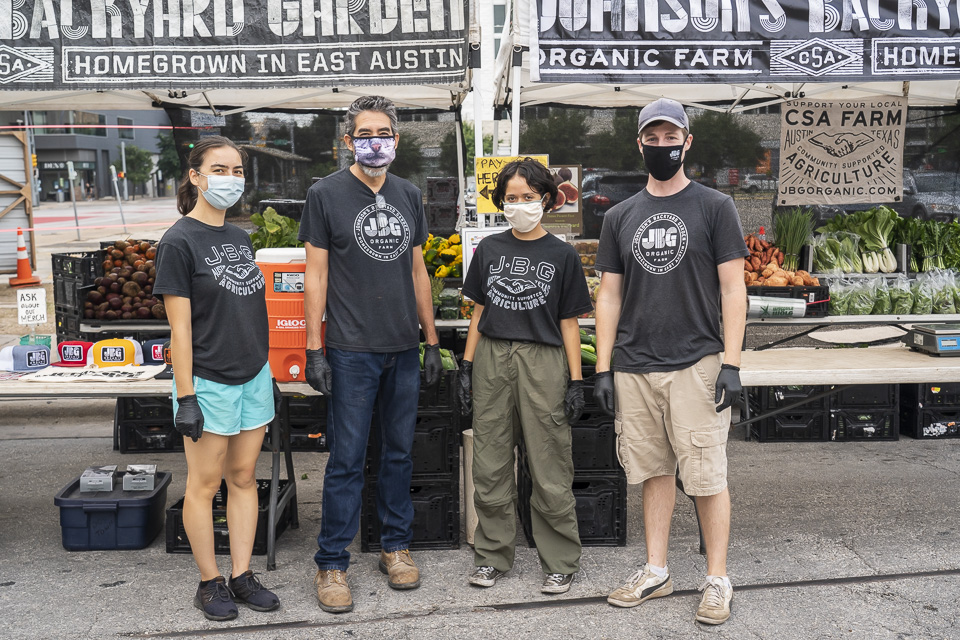 Nao, Rich, Marcela, & Jerry: Our Downtown Crew!
Nao, Rich, Marcela, & Jerry: Our Downtown Crew!
We work hard to fill our booths with mesmerizing mountains of beets and colorful carousels of carrots. These displays are more than pretty pictures, however, and we’re also creating a layout that is ergonomic for our staff and makes for a safe and pleasurable experience for our customers. We’ve been attending markets for over 15 years, and we’ve got a system down! We hope that when you visit us on Saturday or Sunday morning we make the veggie business look easy. But of course, there is an enormous amount of sweat, figuring, and planning that goes into creating a mobile and temporary produce stand. This week we are pulling back the curtain and showing you what goes into our weekend market display, a display that wouldn’t be possible without our fun-loving and talented market staff…. and the reliable functioning of their 4am alarm bells.
THURSDAY AND FRIDAY: Our Farmers Market Manager, Jerry, works on a Thursday through Monday schedule. Thursdays and Fridays Jerry spends the majority of his day hidden away in our coolers, a series of four separate rooms (and two sizeable cubbies), most of which are linked together by large and cumbersome doors and rubber curtains that make you feel like you’re entering a car wash everytime you push your way through. On Thursdays and Fridays, Jerry is charged with the enormous task of “building the market pallets”. Each market has an unofficial official parking spot in the aptly named “market cooler” and on Thursday mornings, Jerry begins by placing empty pallets in the designed areas. Over the course of two days, Jerry will build the pallets with freshly washed, sorted, and sometimes bagged produce, making sure to send a little bit of each item to every market. The quantities he’s packing aren’t random. The number of cucumbers we send to the Sunset Valley market, for example, is a finely tuned figure based off annual records, as well as the “market notes” and sales records from the previous weekend.
Even though Jerry works sometimes a 13 hour day on Saturdays, when asked he said Friday was his most challenging day at work. Head to any market JBG attends and right now you'll see bulk beets. If you love beets, you can thank Jerrry! Each market gets around 2-3 bins of beets (each weighing about 35 lbs.) and Jerry is responsible for physically packing and stacking those 1,000 lbs of beets. And those are just the figures for beets… we sometimes send upwards of 30 different items to market. We’ll save Jerry the headache of seeing the full figures, but he no doubt moves, carries, and shuffles thousands of pounds of vegetables every week, and the weekend’s smooth success depends on his dedication.
FOUR AM TO 7AM SATURDAY MORNING: Market mornings start out at our Hergotz Packing Shed (Barn) location. On Saturdays we attend 8 markets, making it the busiest market day by farm. Market drivers with the early shift arrive at the Barn at 4:30am, and those with the late shift roll in at 5:30. Once drivers arrive, they begin a synchronized dance of carts, forklifts, and pallet jackets, all happening in the dark. It’s well rehearsed, and most mornings things go smoothly. There are two main groups working alongside each other on Saturday mornings: those JBGers driving vans to market and those operating the box trucks. The drivers departing in a van work pretty independently on Saturday mornings. If there was one tragedy of the market setup, it’s that the openings in the back of our vans are too small to load vegetables with a forklift. For this reason, van drivers are responsible for hand-loading their bins of produce and market supplies, all the while muttering a prayer that they return home with a significantly emptier truck.
The drivers that operate our big box trucks, and extra long reefer truck, are responsible for managing our busiest markets (bigger markets = more vegetables = bigger trucks). These bigger vehicles will roll-top doors are loaded with a forklift, and these drives all work together on Saturday mornings, some pulling out and staging vegetables with the pallet jacket, and another loading by the light of the forklift. Somehow, our amazing market managers navigate the loading dock’s dark corners, pushing and pulling literal tons of fresh without anything going wrong, even though technically, anything could fail. Think: dead forklift, flat tires, missing CSA boxes. If all goes as smoothly, the vans are gone and the trucks are loaded by 6:30 am. The next 30 minutes, there as a buffer, are ideally spent filling water bottles, perhaps some light stretching, and chatting about the new vegetables or new protocol that will be rolled out at market. By 7:05 am, the Hergotz loading dock, once a maze of forklifts and towering pallets of vegetables, is empty, the lingering smell of freshly brewed coffee floating above the concrete.
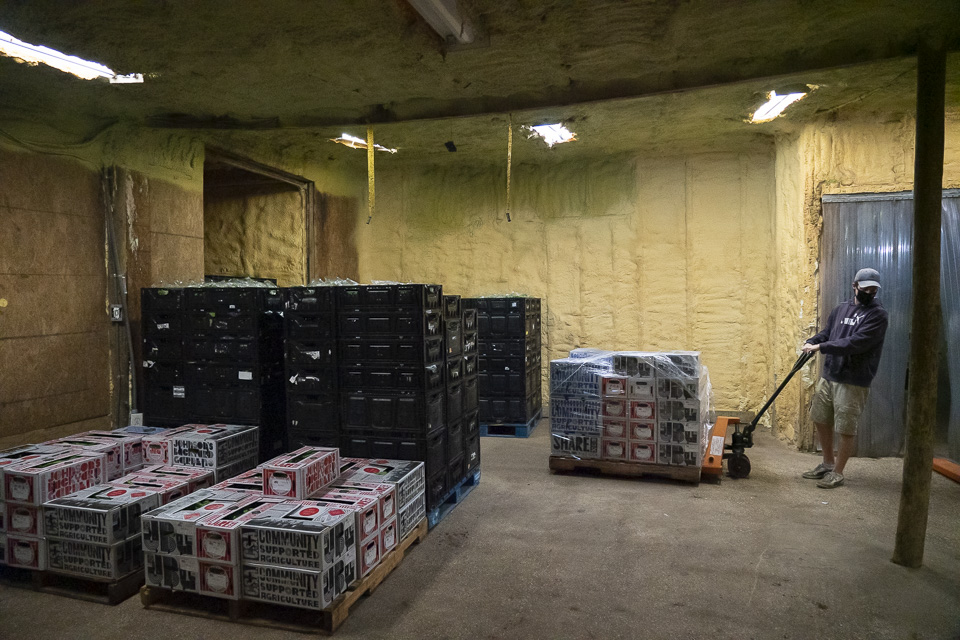 Jerry in his office on Friday morning, pulling out a pallet of CSA boxes.
Jerry in his office on Friday morning, pulling out a pallet of CSA boxes.
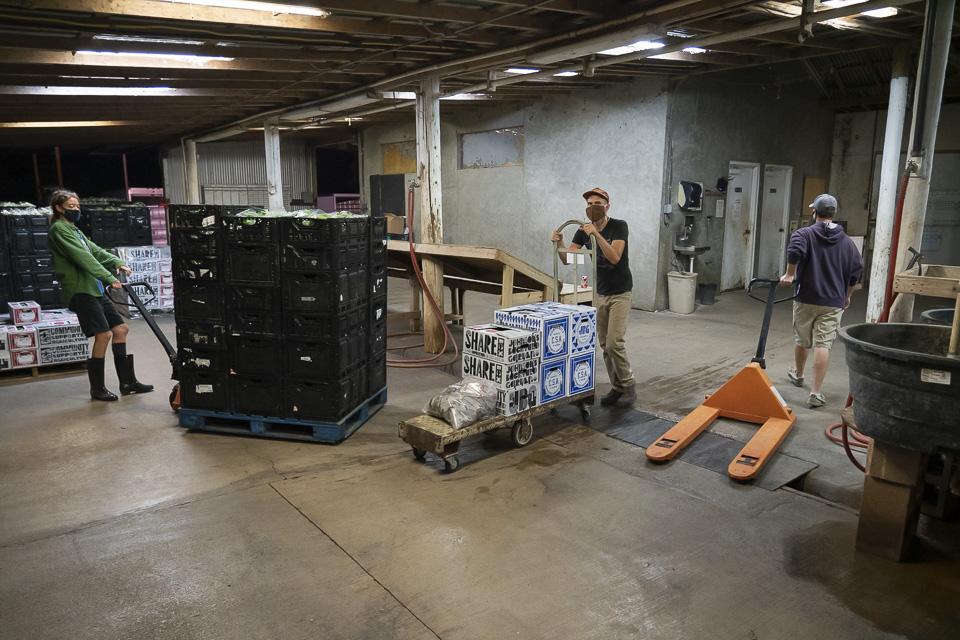 Thankfully, the area under our barn is well lit, and collisions of carts and jacks are rare.
Thankfully, the area under our barn is well lit, and collisions of carts and jacks are rare.
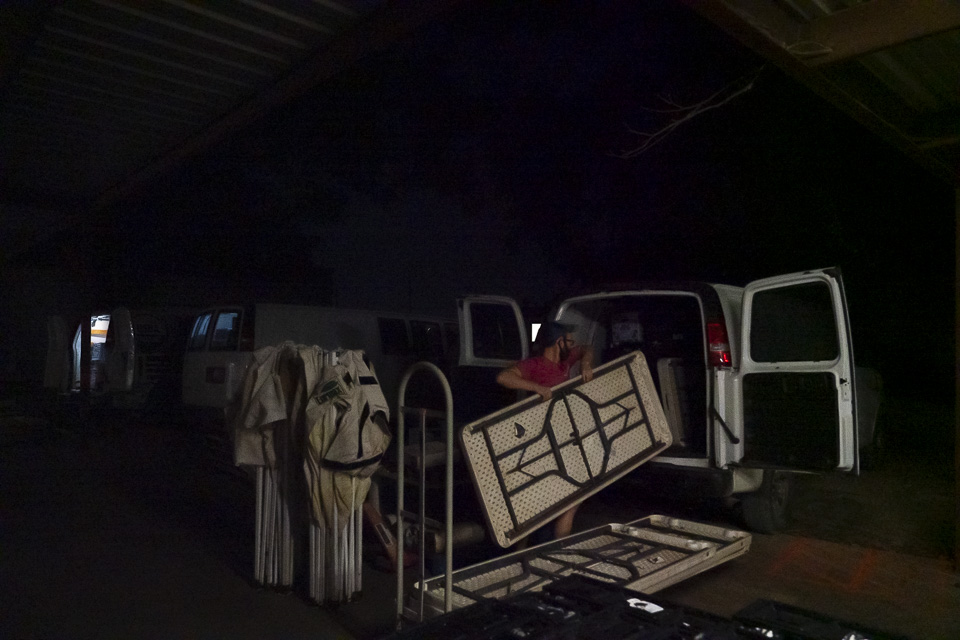 A driver taking a van to market must hand-load market supplies like tables, tents, and of course: vegetables.
A driver taking a van to market must hand-load market supplies like tables, tents, and of course: vegetables.
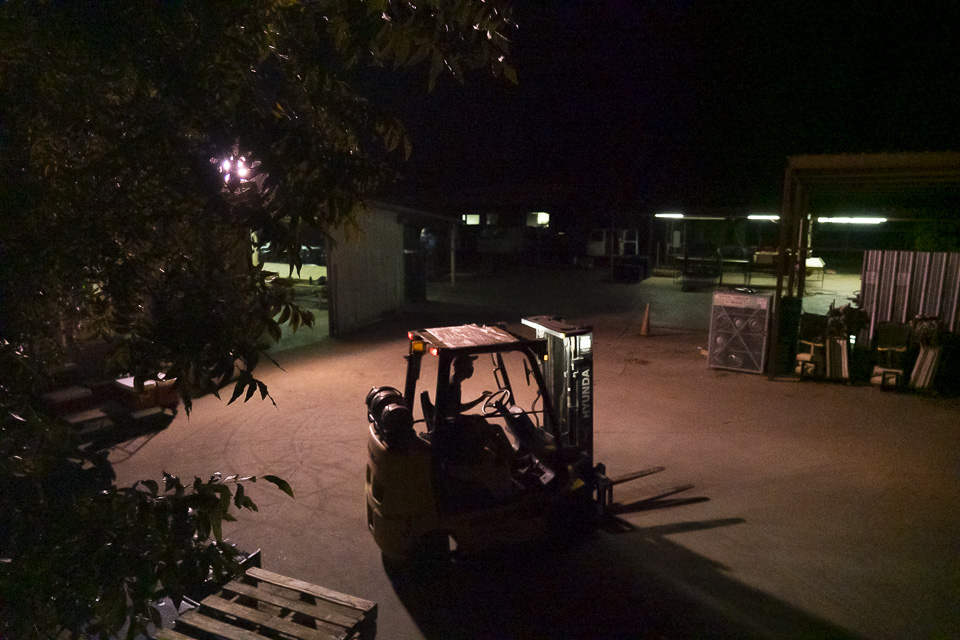 Fork lift dances.
Fork lift dances.
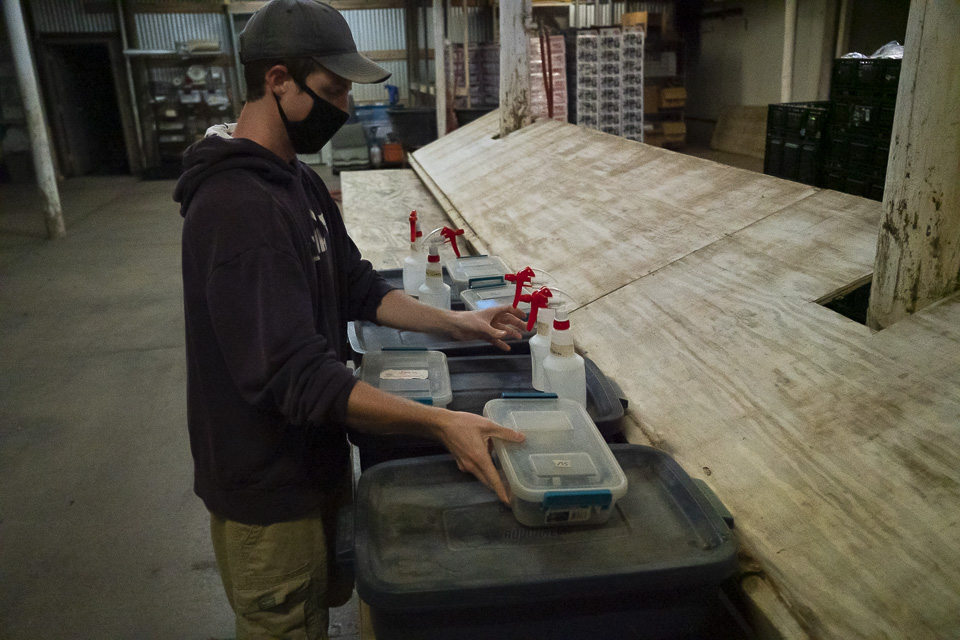 Jerry making sure every market has their merch bin, credit card machine, and hand sanitizer.
Jerry making sure every market has their merch bin, credit card machine, and hand sanitizer.
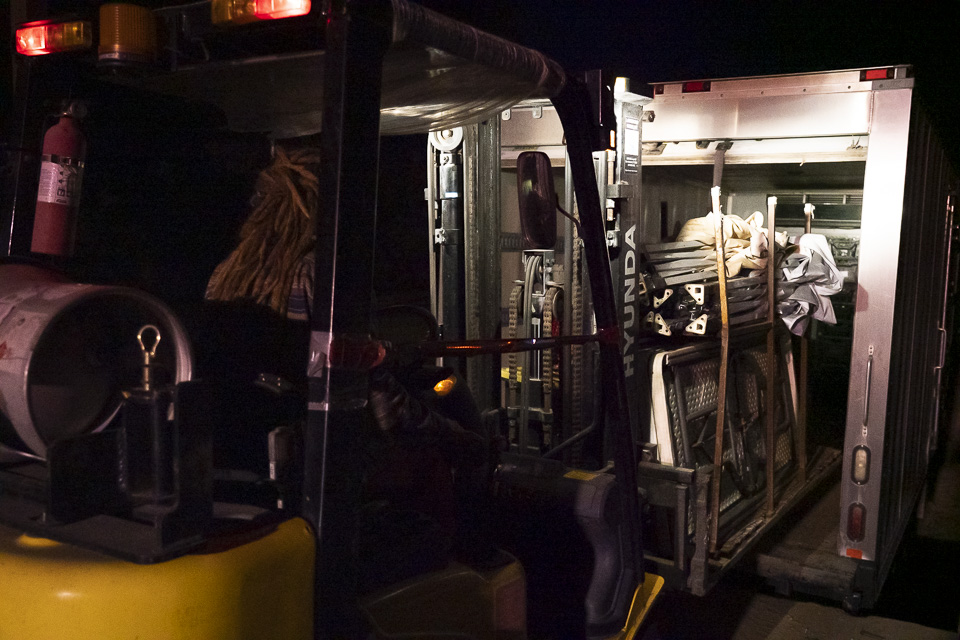 Amy loading all of the market supplies onto a box truck. Tents, tables, scales, and supplies are stored together on metal farmes that we call "wunder pallets". With a forklift, all of these supplies can be loaded at once onto a box truck.
Amy loading all of the market supplies onto a box truck. Tents, tables, scales, and supplies are stored together on metal farmes that we call "wunder pallets". With a forklift, all of these supplies can be loaded at once onto a box truck.
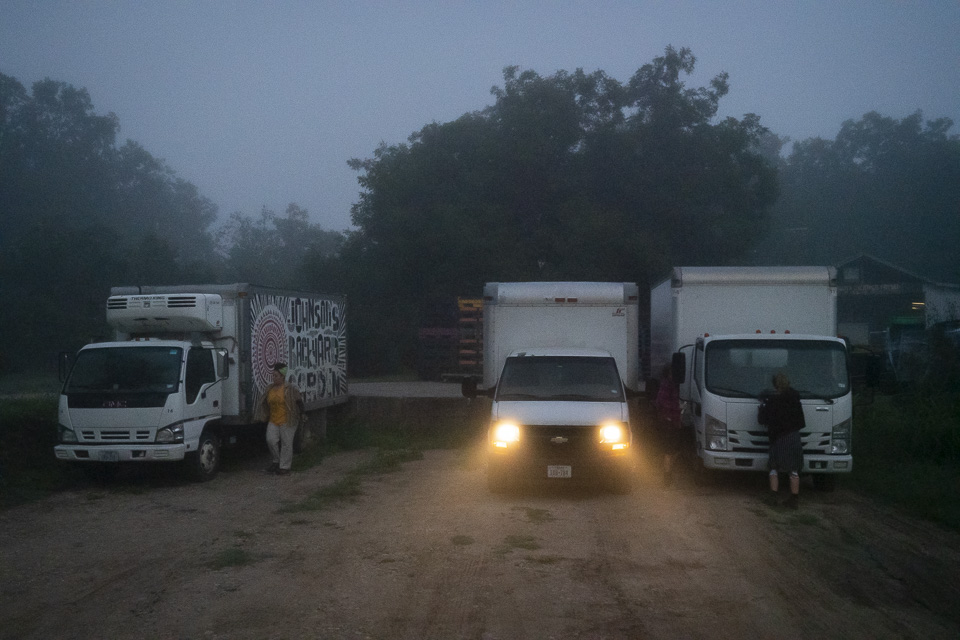 Lights, camera, action. By 7:05, all of these trucks will be long gone.
Lights, camera, action. By 7:05, all of these trucks will be long gone.
AT MARKET: Our photographer Scott followed behind as Jerry left dusty Hergotz Lane and headed a couple of miles west, to SFC’s Downtown Market. Over the past 10 years, Scott has captured thousands of moments of farm life. But even for Scott, the process of market setup was a mystery. Like any good event, no one is supposed to see the setup, correct? At each and every market we attend, our market staff is usually the first to the scene. Slowly, other vendors arrive, and empty parking lots transform into bustling markets where you can get your mushrooms, vegetables, meats, and coffee all in stop.
Like the dance that happens at the Hergotz loading dock, the actual setup of tents, tables, and displays of vegetables is a choreographed routine where muscle memory and artistic intuition manifest into an organic produce shop that would rival many grocery stores. Take a look at Scott’s photos to see each setup step.
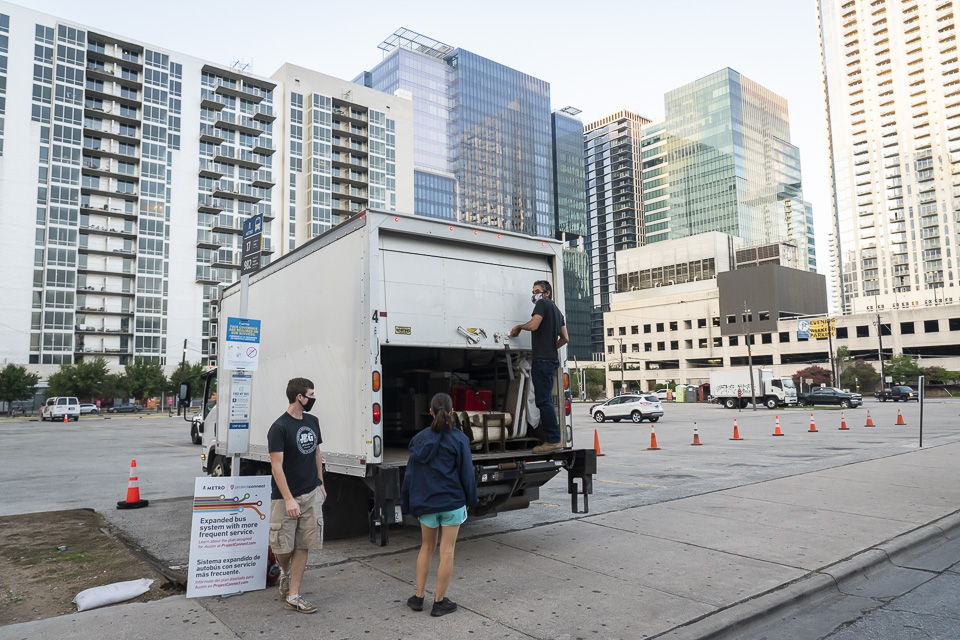 We're usually the first scene at the farmers' market. First step: open the door.
We're usually the first scene at the farmers' market. First step: open the door.
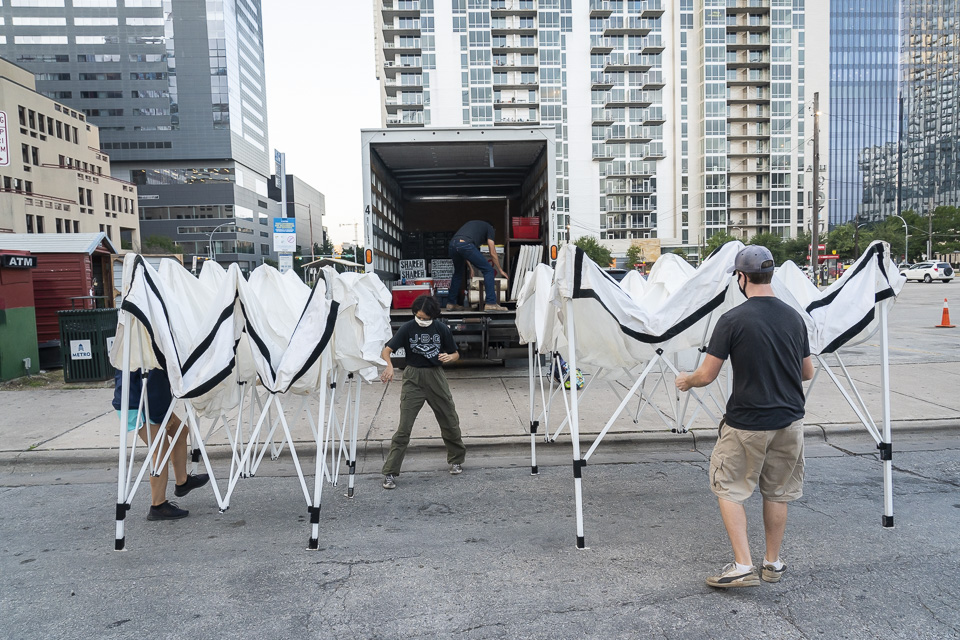 Open the tents. Marvel at early morning sky reflected in the surrounding skyscrapers.
Open the tents. Marvel at early morning sky reflected in the surrounding skyscrapers.
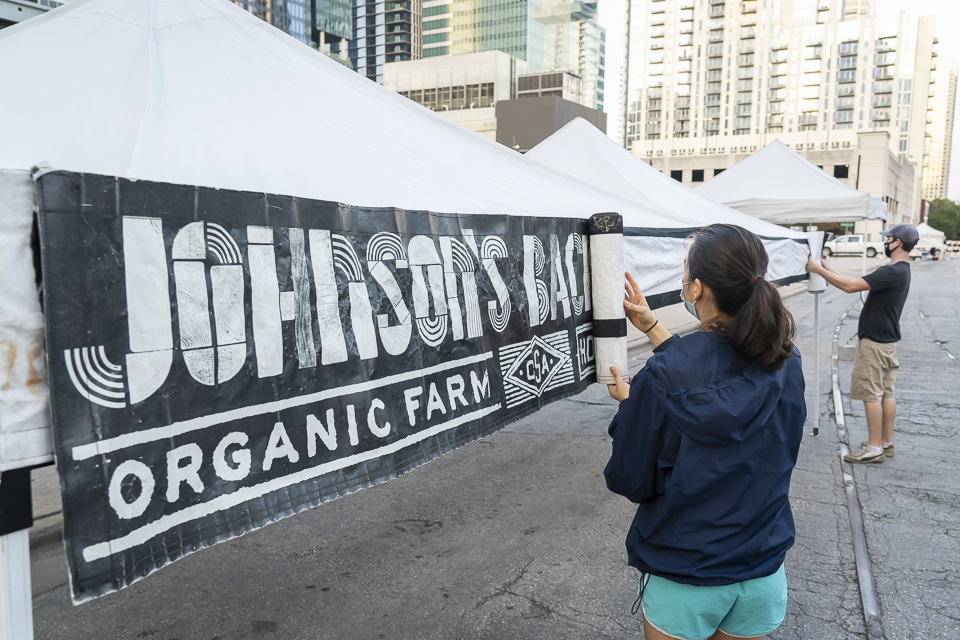 Don't forget to attach the sign before you raise the tent. That's a rookie mistake.
Don't forget to attach the sign before you raise the tent. That's a rookie mistake.
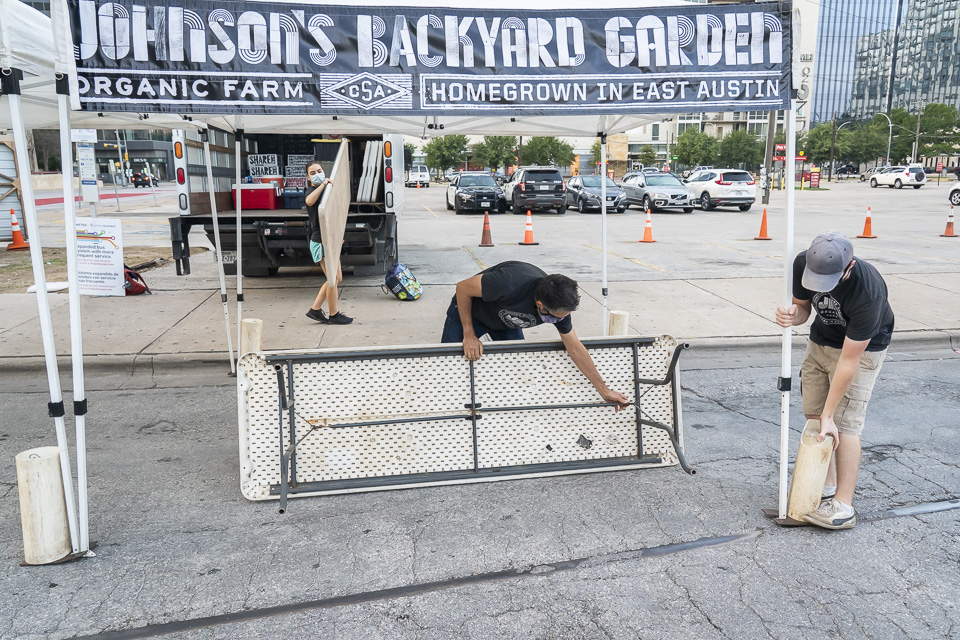 Safety first: attach the tent weights before doing much else. These are home-made weights - pvc pipes with a metal foot at the bottom, clip at the top, filled with concrete.
Safety first: attach the tent weights before doing much else. These are home-made weights - pvc pipes with a metal foot at the bottom, clip at the top, filled with concrete.
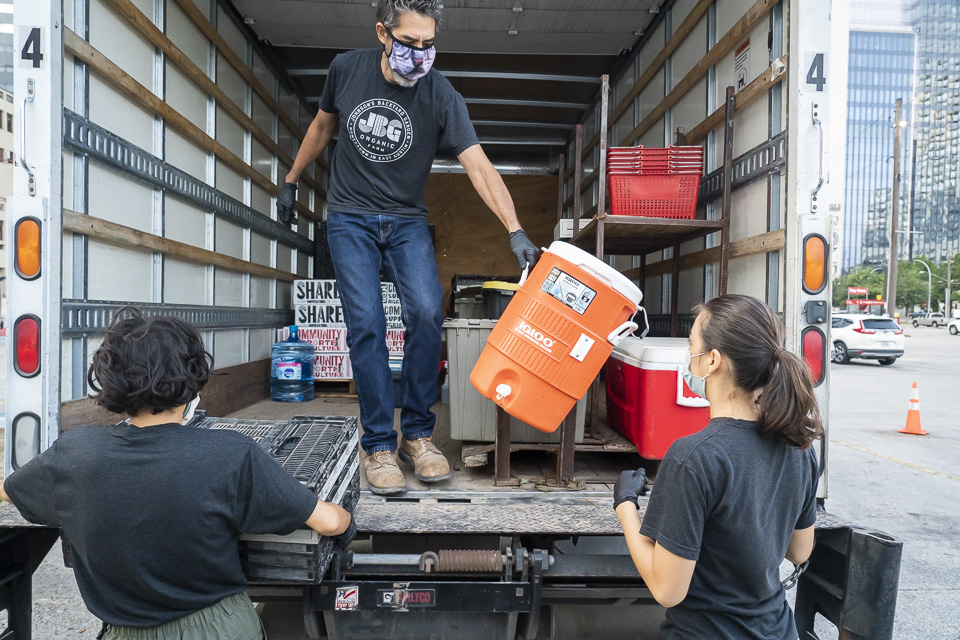 Unloading: One person stands in the back of the truck and deliveries all the supplies to the rim, including a cooler of water so we can stay hydrated.
Unloading: One person stands in the back of the truck and deliveries all the supplies to the rim, including a cooler of water so we can stay hydrated.
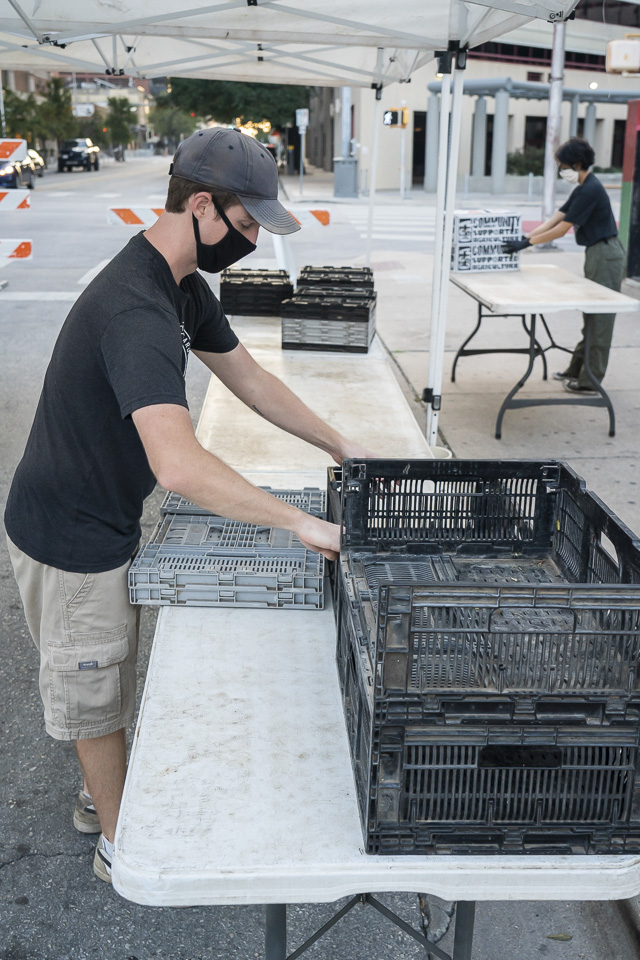 Jerry builds the soon-to-be veggie displays with stacked ifcos. Marcela sets up the CSA table.
Jerry builds the soon-to-be veggie displays with stacked ifcos. Marcela sets up the CSA table.
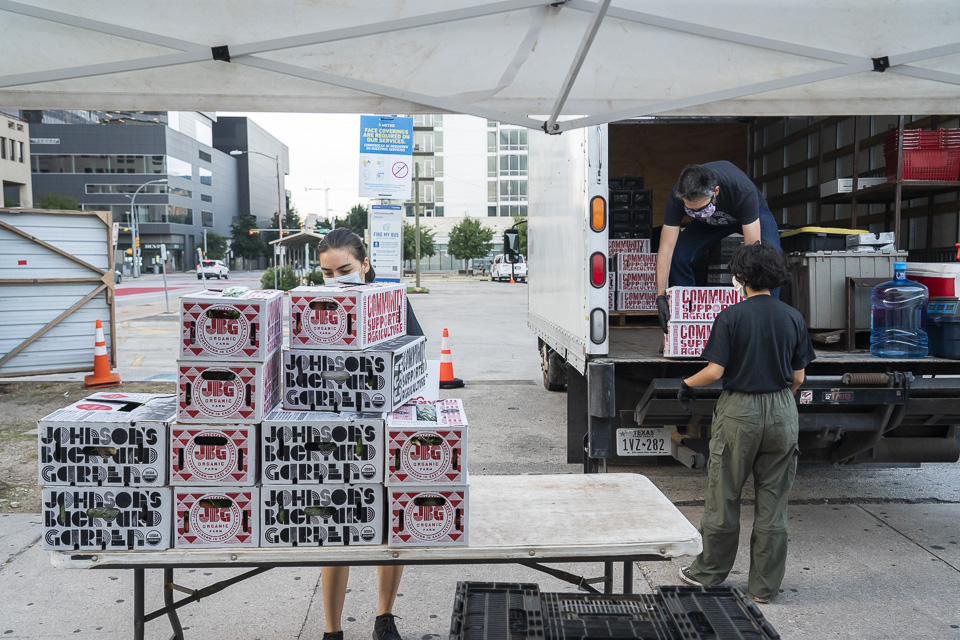 Did you know that you can schedule to pickup a CSA box at a farmer's market? Pay ahead of time, grab and go.
Did you know that you can schedule to pickup a CSA box at a farmer's market? Pay ahead of time, grab and go.
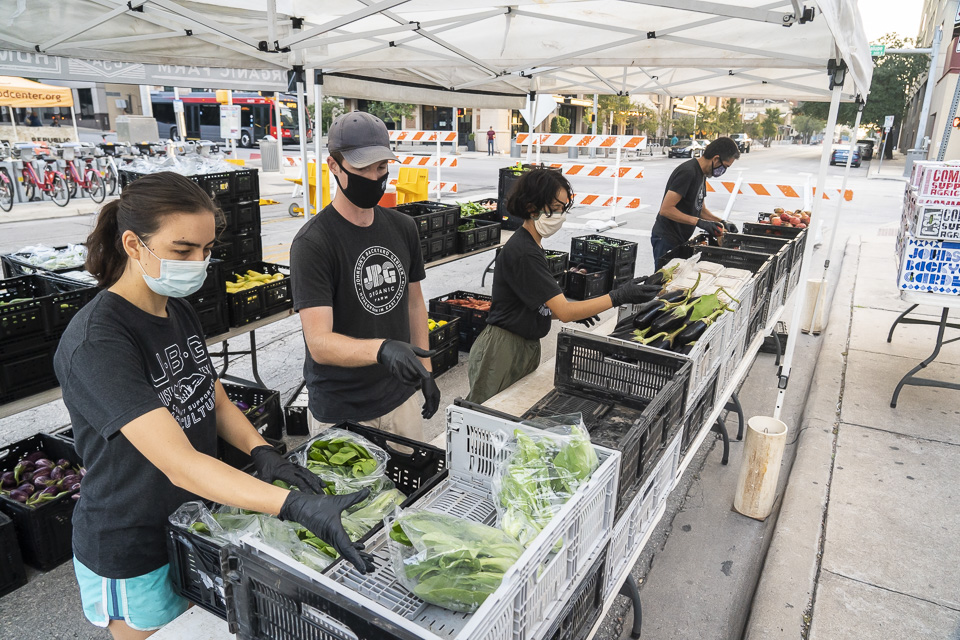 Coloring in the lines.
Coloring in the lines.
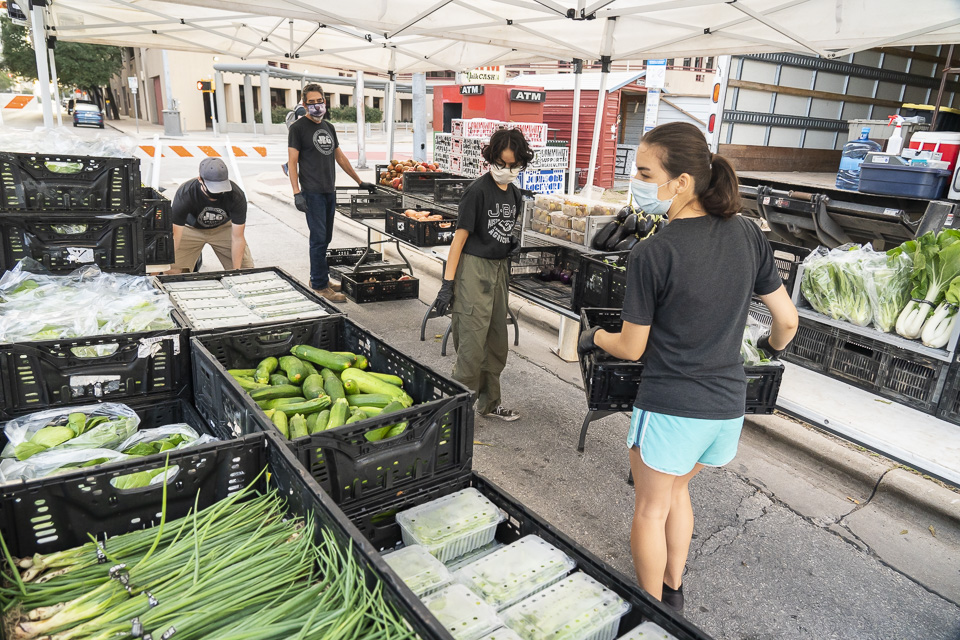 Some quick deliberation. SFC's Downtown market opens at 9am and the clock is ticking. There is nothing worse than not being setup as customers arrive.
Some quick deliberation. SFC's Downtown market opens at 9am and the clock is ticking. There is nothing worse than not being setup as customers arrive.
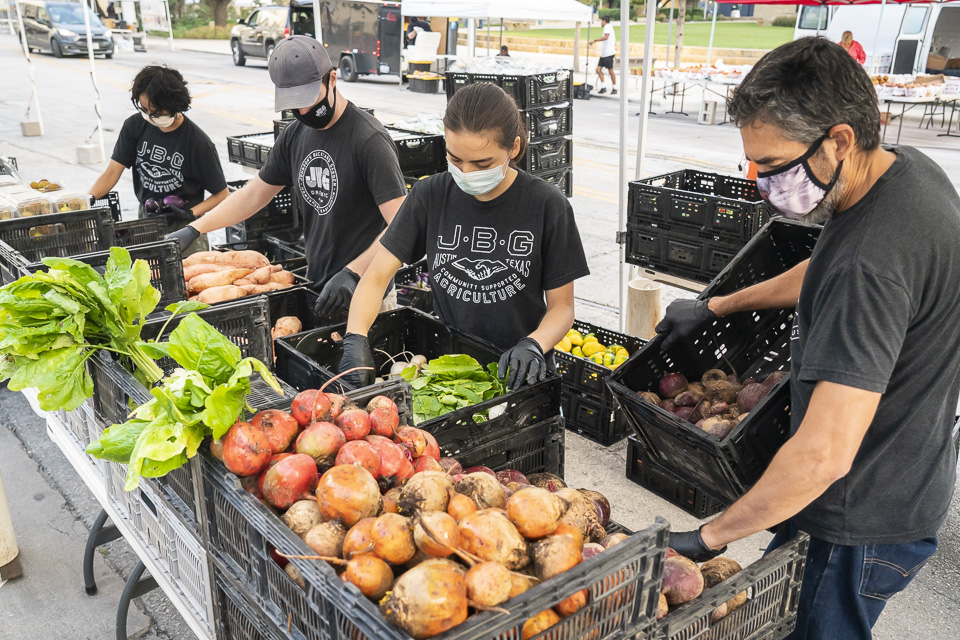 Everything is off the truck, and the display is taking shape.
Everything is off the truck, and the display is taking shape.
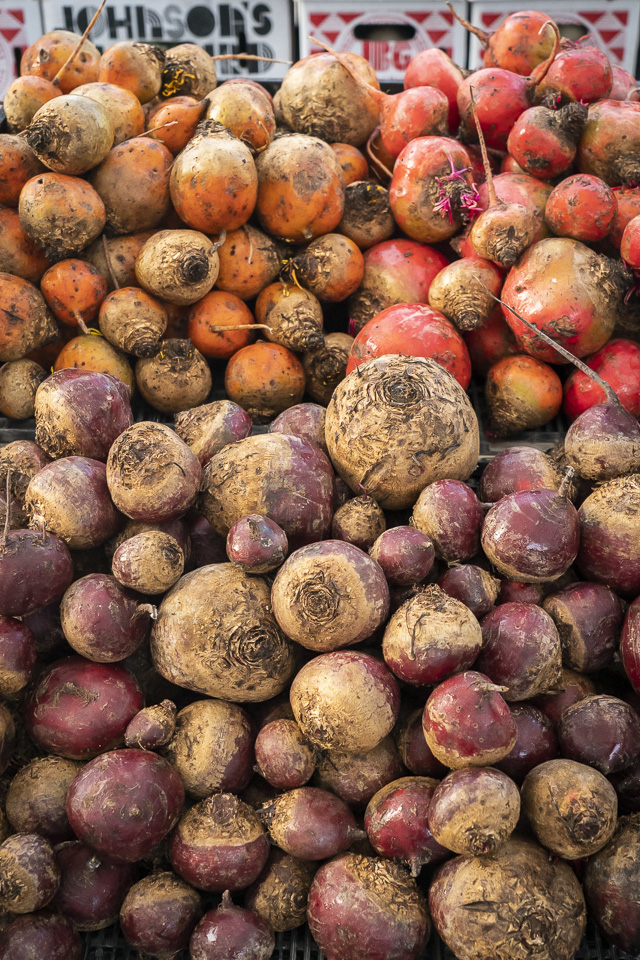 We send an average of 100 lbs. of bulk beets to each market.
We send an average of 100 lbs. of bulk beets to each market.
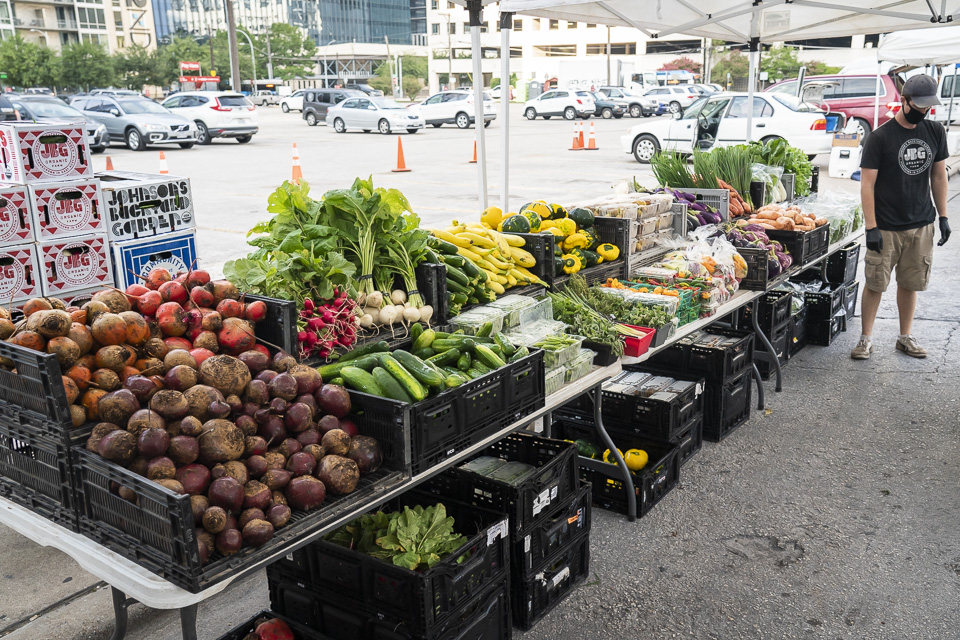 Since March, we've modified our market display so that only JBG employees can touch vegetables. All of the day's offerings are displayed in one long line, and customers "order" what they'd like from the checkout.
Since March, we've modified our market display so that only JBG employees can touch vegetables. All of the day's offerings are displayed in one long line, and customers "order" what they'd like from the checkout.
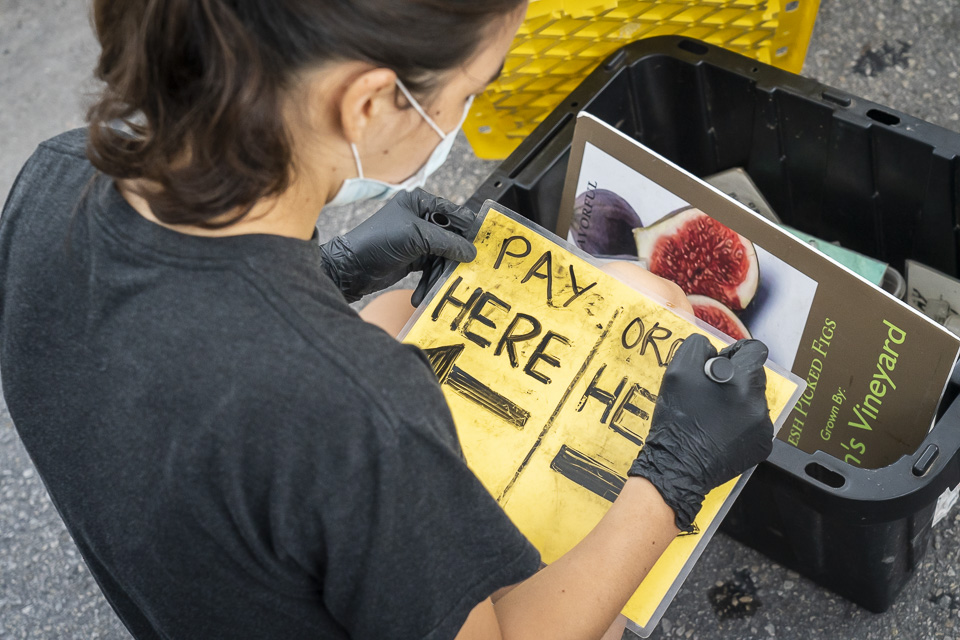 Sinage helps keep things flowing.
Sinage helps keep things flowing.
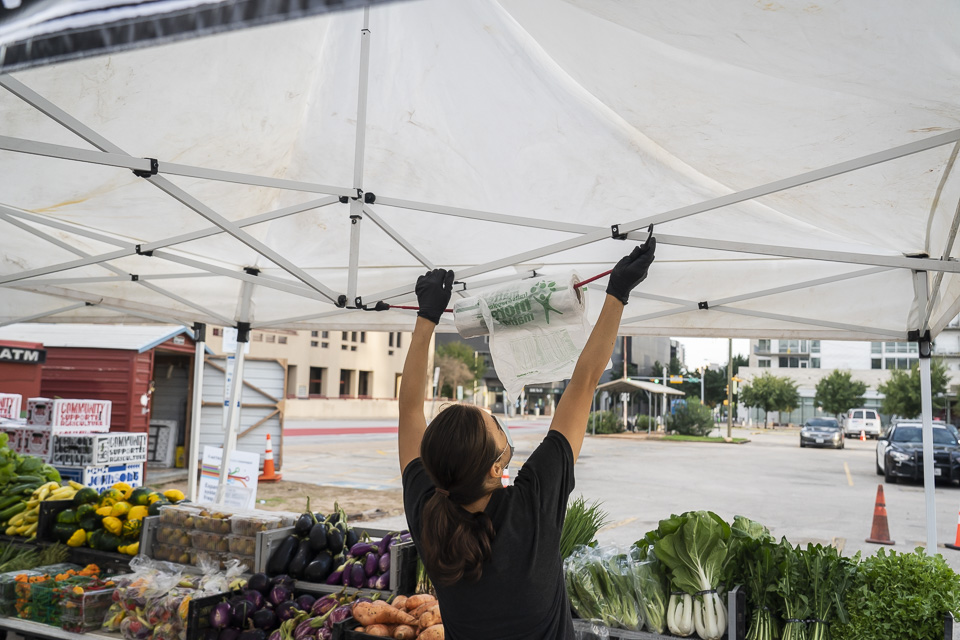 Bungie cords are a particularly useful market tool.
Bungie cords are a particularly useful market tool.
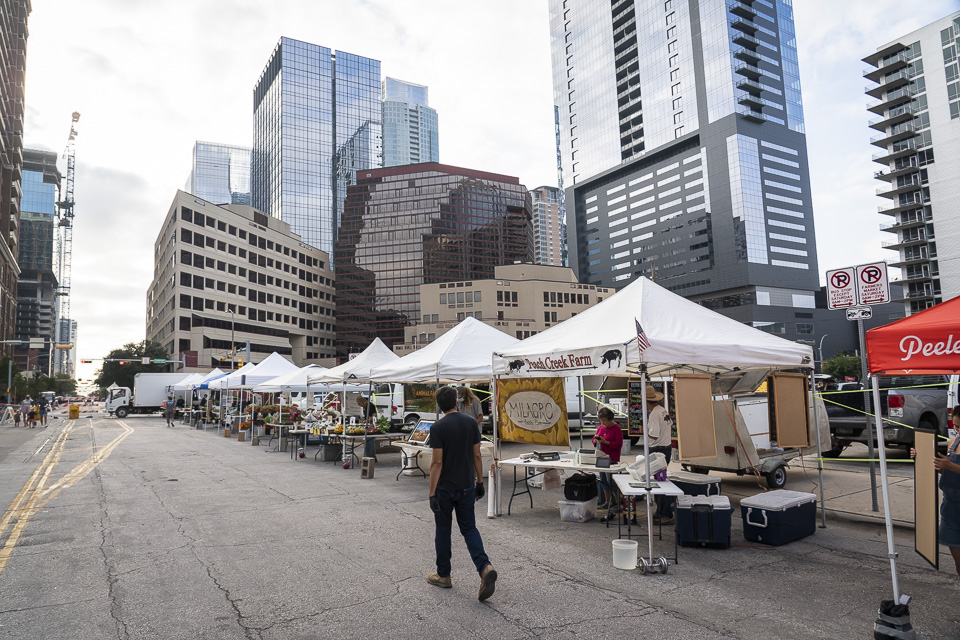 And just like that, there is an entire market in Downtown Austin! Time to go grab a cup of coffee before customers descend.
And just like that, there is an entire market in Downtown Austin! Time to go grab a cup of coffee before customers descend.
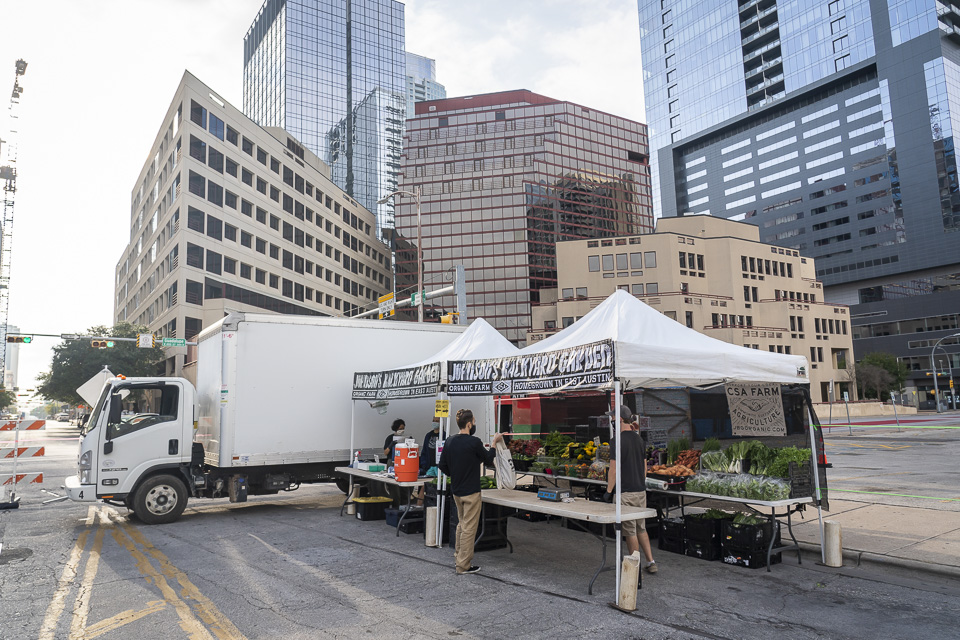 Our first customer of the day. We are ready.
Our first customer of the day. We are ready.
WHEN IT’S ALL DONE: The average market shift is a 12 hour day, though our valiant crew that drives places like Houston and Waco often work longer hours. Generally, the length of a shift also can vary depending on the season. The more vegetables that are in season, the more bins of produce we attempt to sell, which takes longer to setup and breakdown.
After tearing down tents and consolidating bins of vegetables, the trucks are re-loaded so they can make the trek home. Jerry is often the first one back at the barn, and drivers from other markets trickle in for the next 30 minutes. It’s a jovial time at the barn - everyone is a tad delirious and is certainly pumping with a little adrenaline and lots of joy that come from meeting our customers and serving the community vegetables. There is one last cleanup dance that needs to happen before the crew can go home. Trucks are unloaded, supplies returned to their spot on the loading dock, and the leftover vegetables are brought back into the market cooler where they are sorted. You’ll usually find Jerry in the cooler cave, again, on Saturday afternoons. There, he’s finalizing the packing for Sunday markets. Half of the market staff help Jerry with this task, and the other half tackle the unglamorous and monotonous job of cleaning and sanitizing all of the empty bins that once contained the day’s offerings.
MONDAY: Each Monday, or Jerry’s “Friday”, he spends the day getting closure on the weekend. Have you ever thrown a ruckus house party involving loads of people and tons of food? If you can remember what that was like, call to mind the state of your kitchen the morning after such an event. To some degree, Jerry spends Monday cleaning up after the weekend’s wild festivities. Ideally, our market staff are returning bins of produce and supplies in a tidy manner, but sometimes a market shift can be such a busy whirlwind that beets mix with carrots, and the supply bin looks like a junk drawer. Our market staff also take detailed notes of the day's sales, which Jerry enters into a spreadsheet, and note any problems with vehicles or supplies that need restocking. Dry erase markers, rags, price signs, sign clips, credit card machines, credit card paper, table cloths, sanitizer, bungee cords, merchandise, brochures, cash registers, tables, tents, weights…. One missing or broken piece of equipment could make for a lousy market experience for our staff. Luckly, we have Jerry and Monday mornings to make it all right when the cycle begins again in a few short days.
We hope you’ve enjoyed this behind the scenes look at how we farmers’ market and we hope to see you at a market this weekend! Consider helping our market staff out and buying a few more beets than seems reasonable… the more you take home, the less we have to lug back. As always, thanks for reading!






 0 ITEMS IN CART
0 ITEMS IN CART 

